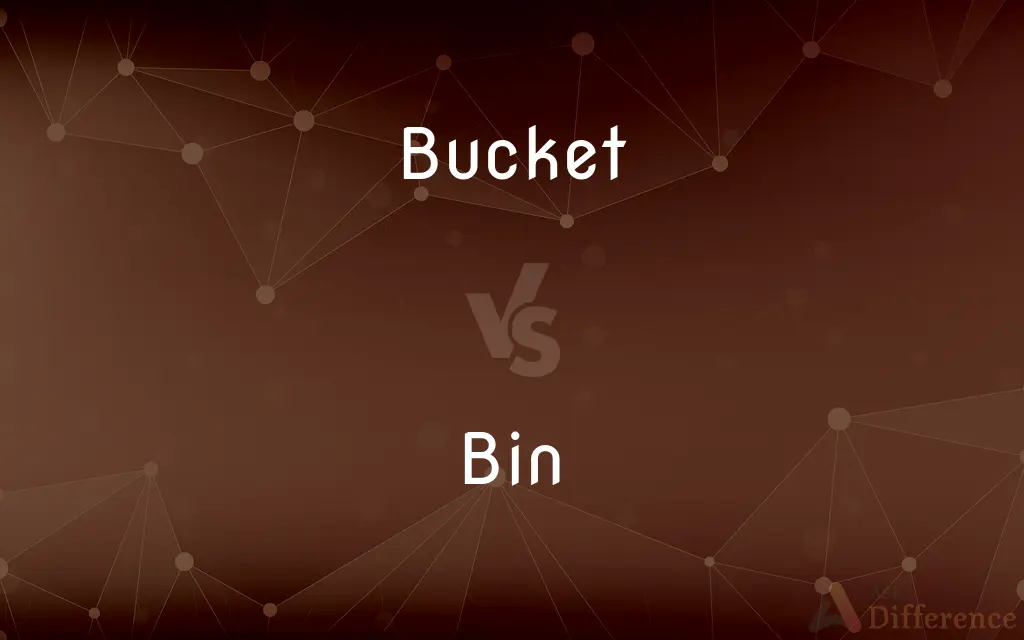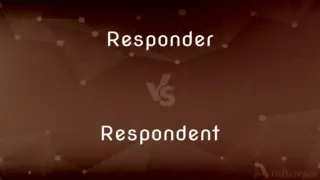Bucket vs. Bin — What's the Difference?
By Tayyaba Rehman & Urooj Arif — Updated on February 24, 2024
A bucket is a cylindrical container with a handle used for carrying liquids, while a bin is a larger container for storing or disposing of solid materials.

Difference Between Bucket and Bin
Table of Contents
ADVERTISEMENT
Key Differences
Buckets are typically designed for holding and carrying liquids, made from materials like plastic or metal, and come with a handle. Bins are used for storing or disposing of solid waste or other materials. They can be made from various materials, including plastic, metal, or wood, and usually do not have handles. Bins serve a broad range of purposes, from household waste disposal to storage of items like toys or tools.
The primary function of a bucket is to transport liquids or small quantities of materials from one place to another, emphasizing portability and ease of use. The presence of a handle facilitates this, making buckets suitable for tasks that involve pouring or transferring contents. Bins are primarily stationary and focus on containment or organization. They are larger and designed to hold more material, making them ideal for waste collection, recycling, or storing bulk items. The lack of a handle underscores their purpose as stationary containers rather than for transport.
Buckets are for carrying liquids with ease, thanks to their handles and shape, while bins are for collecting or storing solids, designed to be more stationary and handle-free. bins are focused on the containment and storage of solid materials, often serving as receptacles for waste or organizational containers for various items. Unlike buckets, bins typically do not feature handles and are designed to remain stationary in a single location, such as a kitchen, office, or public space. Their larger size and variety of materials, including plastic, metal, and wood, accommodate a wider range of uses from waste disposal to the storage of goods.
Buckets are often used in cleaning, gardening, or construction tasks. For example, a bucket can be used to mop floors or carry water for plants. Bins play a crucial role in waste management systems, helping to segregate and manage waste efficiently, and can also be used to store items in a more organized manner.
Comparison Chart
Primary Use
Carrying liquids or small materials
Storing or disposing of solid materials
ADVERTISEMENT
Material
Plastic, metal
Plastic, metal, wood
Feature
Handle for easy carrying
Usually larger, without handles
Function
Transport and pour liquids
Contain or store solids
Typical Location
Gardens, cleaning closets, construction sites
Homes (kitchen, office), public spaces
Compare with Definitions
Bucket
Often made of durable materials like plastic or metal.
The metal bucket resisted the heat from the coals.
Bin
A container or enclosed space for storage.
Bucket
The amount that a bucket can hold
One bucket of paint will be enough for the ceiling.
Bin
A box, frame, crib, or enclosed place, used as a storage container.
A corn bin
A wine bin
A coal bin
Bucket
A cylindrical vessel for carrying liquids with a handle.
She filled the bucket with water to wash the floor.
Bin
To dispose of (something) by putting it into a bin, or as if putting it into a bin.
Bucket
(transitive) To place inside a bucket.
Bin
A container; usually has a lid
Bucket
A vessel for drawing up water from a well, or for catching, holding, or carrying water, sap, or other liquids.
The old oaken bucket, the iron-bound bucket,The moss-covered bucket, which hung in the well.
Bin
A container used for storage or waste disposal.
She threw the packaging into the recycling bin.
Bucket
To draw or lift in, or as if in, buckets; as, to bucket water.
Bin
Serves to organize, store, or dispose of items.
He placed the documents in the shred bin at the office.
Bucket
To pour over from a bucket; to drench.
Bin
To place or store in a bin.
Bucket
Portable and designed for manual handling.
The firefighter used a bucket to carry water quickly.
Bin
A container for rubbish or waste.
A rubbish bin
A wastepaper bin
An ashes bin
Bucket
Can be used for mixing or preparing small quantities of material.
The chef used a bucket to mix the marinade.
Bin
Can be specific to waste type, like recycling or compost.
The compost bin was set up in the kitchen.
Bucket
A cylindrical vessel used for holding or carrying liquids or solids; a pail.
Bin
The quantity contained in a bin
Bucket
To hold, carry, or put in a bucket
Bucket up water from a well.
Bin
Made from a variety of materials for different uses.
The wooden bin held logs for the fireplace.
Bucket
The amount held in this container.
Bin
Store in bins
Bucket
The basket.
Bin
Larger than buckets and often without handles.
The bin was filled with toys in the playroom.
Bucket
A roughly cylindrical that is vessel open at the top
Bucket
The quantity contained in a bucket
Bucket
Used in various applications from cleaning to gardening.
He carried a bucket of paint to the work site.
Bucket
A bucket is typically a watertight, vertical cylinder or truncated cone or square, with an open top and a flat bottom, attached to a semicircular carrying handle called the bail.A bucket is usually an open-top container. In contrast, a pail can have a top or lid and is a shipping container.
Bucket
A container made of rigid material, often with a handle, used to carry liquids or small items.
Common Curiosities
What is the primary purpose of a bucket?
To carry and transport liquids or small quantities of materials, often facilitated by a handle.
What distinguishes a bin from a bucket in terms of design?
Bins are typically larger, designed for stationary use without handles, while buckets are portable with handles.
Are buckets only for liquids?
While designed primarily for liquids, buckets can also carry solids, like sand or soil.
Can a bucket be used as a bin?
In some contexts, yes, but buckets are not typically designed for waste storage due to their smaller size and handle.
Can bins have lids?
Yes, many bins, especially those used for waste, have lids to contain odors and materials.
How do you choose between a bucket and a bin?
It depends on the intended use: carrying liquids or small items (bucket) vs. storing or disposing of solids (bin).
Can bins be used for storage aside from waste?
Absolutely, bins are versatile and can store a variety of items, from toys to tools.
How do sizes typically compare between buckets and bins?
Bins are generally larger to accommodate more or bulkier materials, while buckets are sized for easy carrying.
Why are bins important for waste management?
Bins help segregate, organize, and manage waste efficiently, contributing to recycling and sanitation efforts.
Are there eco-friendly options for buckets and bins?
Yes, many are made from recycled materials or designed to be recyclable themselves.
Are there different types of bins?
Yes, including recycling bins, compost bins, and trash bins, each designed for specific types of waste.
What are common materials for buckets and bins?
Buckets are often made from plastic or metal for durability, while bins can also include wood.
What is the significance of a handle on a bucket?
The handle makes it easier to carry and pour the contents, enhancing the bucket's utility.
How does the design of a bin affect its use?
The design, including size, material, and whether it has a lid, determines its suitability for specific storage or waste disposal needs.
What role do buckets play in emergency situations?
Buckets can be crucial for transporting water or sand to manage fires or for cleaning after natural disasters.
Share Your Discovery

Previous Comparison
Geography vs. Geology
Next Comparison
Responder vs. RespondentAuthor Spotlight
Written by
Tayyaba RehmanTayyaba Rehman is a distinguished writer, currently serving as a primary contributor to askdifference.com. As a researcher in semantics and etymology, Tayyaba's passion for the complexity of languages and their distinctions has found a perfect home on the platform. Tayyaba delves into the intricacies of language, distinguishing between commonly confused words and phrases, thereby providing clarity for readers worldwide.
Co-written by
Urooj ArifUrooj is a skilled content writer at Ask Difference, known for her exceptional ability to simplify complex topics into engaging and informative content. With a passion for research and a flair for clear, concise writing, she consistently delivers articles that resonate with our diverse audience.














































